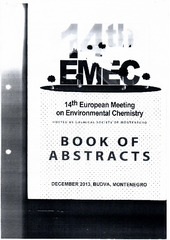Приказ основних података о документу
Persistence and dissipation behavior of dicamba and bentazon herbicides in water under laboratory conditions
| dc.creator | Lazić, S. | |
| dc.creator | Šunjka, D. | |
| dc.creator | Grahovac, Nada | |
| dc.creator | Guzsvány, V. | |
| dc.date.accessioned | 2023-08-17T09:02:07Z | |
| dc.date.available | 2023-08-17T09:02:07Z | |
| dc.date.issued | 2013 | |
| dc.identifier.isbn | 978-9940-9059-1-0 | |
| dc.identifier.uri | http://fiver.ifvcns.rs/handle/123456789/3732 | |
| dc.description.abstract | The characteristics of water used in a spray mix influence the effectiveness of pesticides. It is important to know the pH of water used with a pesticide and the susceptibility of the pesticide to hydrolysis. In order to investigate the persistence, dissipation and degradation kinetics of bentazone and dicamba, laboratory study was conducted in deionized water (pH 7.0) at 2542°C (T1) and 442°C (T2). Herbicides were dissolved at rate of 0.05 mg/ml. Concentration of analytes was monitoried 0 (1h), 2, 4, 7, 10, 14, 18, 24 and 28 days after treatment and analysing as triplicate samples. Samples were analyzed by high pressure liquid chromatography (HPLC/DAD). The chromatographic separation was carried out with Zorbax Eclipse XDB-C,, (50 mm x 4.6 mm x 1.8 pm) analytical column, using reverse phase column with gradient conditions of mobile phase consist of water (with 0.05% H PO,) and acetonitrile. In T1 the dissipation were 1.3, 5.1, 7.5, 7.9, 8.1, 15.3, 24.1, 26.9% for dicamba and 11.5, 33.3, 44.6, 46.9,48.8, 49.6, 50.1, 51.8% for bentazone in 2, 4, 7, 10, 14, 18, 24, and 28 days. Corresponding dissipation in T2 experiment were 2.0, 2.7, 3.9, 5.0, 6.1, 6.9, 6.8, 8.0% for dicamba and 7.7, 15.2, 26.7; 29.4, 30.3, 30.6, 31.4, 31.9% for bentazone, respectively. The dissipation data in water showed the DT, and DT,, values 57.3 and 114.9 days ae for dicamba and 17.1 and 125.9 days for bentazone herbicide. Several simulation models were used to evaluate the experimental data, such as Exponential and Mittag-Leffler function. The dissipation of analized eo . herbicides residues over the time in water were described by the MittagLeffler function, with the best-fit model for dicamba and bentazone [1]. The dissipation of dicamba and bentazone residues on 25+2°C and 442°C es over the time in deinoized water were described by function a*Eo, (-bt). ag Coefficients a, b, a, 8 were obtained from the experimental data by using be fitting procedure. We got for dicamba and bentazone herbicides on a 25+2°C coefficients a=0.8, R=3.71,a=159.11,b=12.79 and a=2.17, B=4.56, Es a=1387.45, b=1.96 for 442 °C a=0.8, B=4.11, a=82.53, b=7.0 and a=0.99, rs G=3.15, a=205.81, b=0.117, respectively. The hydrolysis study indicated that the dicamba and bentazone pesticides hydrolysed faster at 25+2°C. These findings can be useful in the prediction of the dissipation behavior of this pesticides in the spray tank immediately before application. The dissipation rates of dicamba and bentazone pesticides depended on the temperature and pH of water to be used. | sr |
| dc.language.iso | en | sr |
| dc.relation | info:eu-repo/grantAgreement/MESTD/Integrated and Interdisciplinary Research (IIR or III)/43005/RS// | sr |
| dc.relation | info:eu-repo/grantAgreement/MESTD/Technological Development (TD or TR)/31072/RS// | sr |
| dc.rights | openAccess | sr |
| dc.rights.uri | https://creativecommons.org/licenses/by/4.0/ | |
| dc.source | 14th European Meeting on Enviromental Chemistry, Budva, Montenegro | sr |
| dc.subject | herbicides | sr |
| dc.subject | water | sr |
| dc.subject | dissipation | sr |
| dc.subject | dicamba | sr |
| dc.subject | bentazone | sr |
| dc.subject | residues | sr |
| dc.title | Persistence and dissipation behavior of dicamba and bentazon herbicides in water under laboratory conditions | sr |
| dc.type | conferenceObject | sr |
| dc.rights.license | BY | sr |
| dc.citation.epage | 86 | |
| dc.citation.spage | 86 | |
| dc.identifier.fulltext | http://fiver.ifvcns.rs/bitstream/id/9222/bitstream_9222.pdf | |
| dc.identifier.rcub | https://hdl.handle.net/21.15107/rcub_fiver_3732 | |
| dc.type.version | publishedVersion | sr |


